From the perspective of code development data, do Polkadot, Cosmos, and other public chains have a healthy developer ecosystem?
Author: Mihai Grigore, Messari
Compiled by: Dong Xun, 8BTC
How do technical platforms acquire and increase their value in the long term?
According to a16z, the core template for value acquisition in Web3 protocols is the alignment of incentives between developers and users. This often translates into a positive feedback loop between code development and application usage. On one hand, ongoing code development facilitates the creation of widely used applications; on the other hand, the widespread use of applications incentivizes further development of new protocol features.
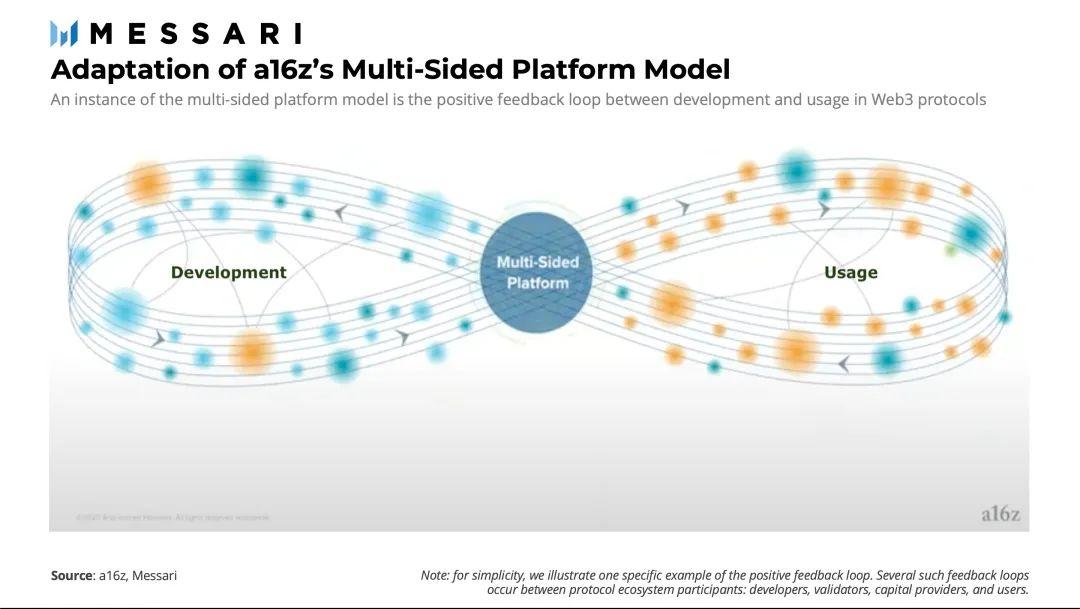
This positive feedback loop is different from the ad-based value capture models seen in Web2 platforms like Amazon, YouTube, or Uber. While the value in Web2 platforms is typically generated by content creators, only a portion of the advertising revenue flows back to them. To maintain and increase value over the long term, Web2 platforms usually incentivize content creators to continuously generate valuable content.
In contrast, the incentive mechanisms of Web3 platforms are more direct, partly due to the transparency of open-source software development. The mechanism of this incentive model is as follows: applications are developed by open-source communities on top of Web3 protocols. As these applications are adopted by users, more funds flow back into the protocol. Thus, value is captured at the protocol layer. This often translates into advanced protocol features that support new applications. As these new applications are adopted by more users, developers are incentivized to build further on "composable" Web3 protocols. As Layer 1 protocols are increasingly adopted, ongoing code development is crucial for creating a lock-in effect that "expands the pie" over time.
However, when analyzing the long-term success of Web3 protocols, few analysts systematically evaluate code development activities. In fact, most analyses focus on on-chain metrics of usage (such as wallet counts, application counts, fund flows, transaction volumes, public sentiment, or media visibility). While most on-chain analysts agree on the importance of code development for the long-term success of Web3 protocols, this topic is largely still considered abstract.
The Missing Piece: Effective Development Metrics
To help address this gap, Santiment and CoinGecko provide customized developer activity metrics. These metrics attempt to independently capture code development progress in GitHub repositories on a per-project basis. A recent report from Galaxy Digital suggests that alternative Layer 1s are closing in on Ethereum in terms of code development. While acknowledging the difficulties in quantifying development activity, the report provides a static comparison of the number of bookmarks in a core GitHub repository as a proxy for current talent concentration.
Another recent report from The Block provides a framework for comparing Layer 1 protocols. The report acknowledges the importance of developer activity in understanding growth prospects. As a proxy for the size of the developer community, the report uses static snapshots of social media engagement from GitHub and Discord data. However, what both reports lack is a summary and longitudinal understanding of ongoing code development trends. To address this shortcoming, let’s analyze GitHub's open-source code development from the following aspects:
- Development Activity: Summarizing the number of code contributions in GitHub
- Developer Community: Summarizing the number of developers who have made at least one code contribution
Below, we include these metrics as part of a comparative study of the four most mature Web3 protocols (sorted by age): Ethereum, Cosmos, Polkadot, and Solana. The same approach can be applied to any other Web3 protocol that gains traction.
Protocol Development Activity
Overall development activity is healthy, and the trends for all four protocols are positive. Since 2014, Ethereum has managed to maintain its first-mover advantage, while development for Cosmos, Polkadot, and Solana began to grow significantly after 2018.
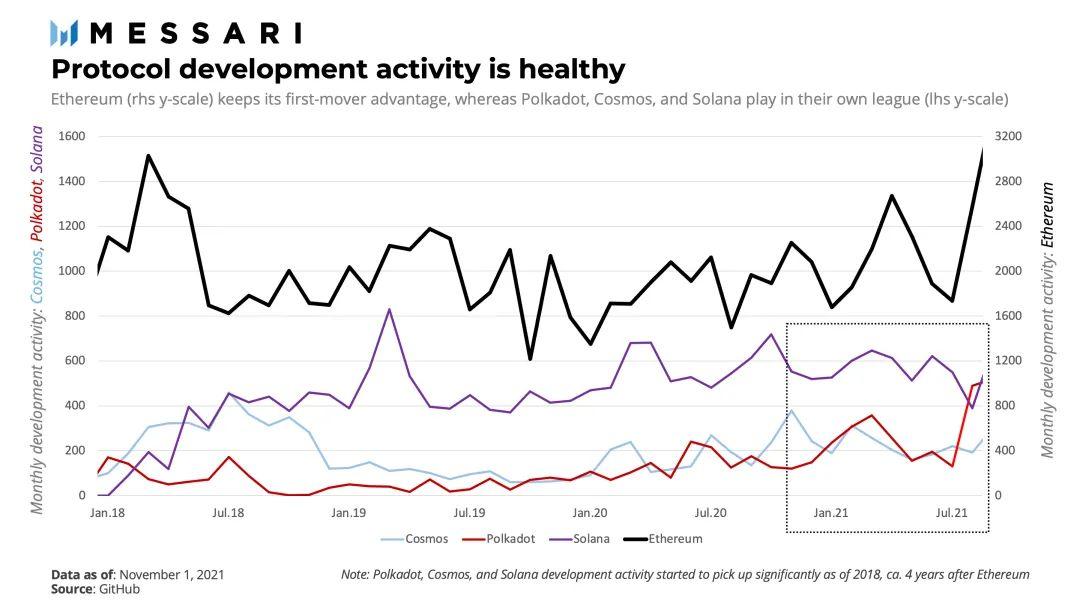
While Solana has had a higher monthly code contribution count (around 500) over the past three years, Polkadot has shown an upward trend in 2021. From this perspective, Polkadot has consistently outperformed Cosmos since Q1 2021 and has been on par with Solana since Q3 2021. The rise in Polkadot's protocol development activity seems to coincide with the timeframe leading up to the first parachain slot auction in November 2021. Meanwhile, Cosmos appears to maintain a long-term steady development pace.
This trend is consistent when comparing year-over-year contributions. In this sense, Polkadot's development activity in 2021 significantly increased compared to Cosmos, Solana, and Ethereum.

Next, let’s look at the scale of contributions, measured by the number of lines of code contributed (added or modified). When accounting for differences between programming languages, larger contributions often correspond to more substantial changes in the code. Therefore, the size of code contributions can serve as a suitable representation of substantive code development. In this sense, Ethereum clearly benefits from larger contributions compared to Cosmos, Polkadot, and Solana. However, it should be noted that both Polkadot and Ethereum show a clear upward trend year-over-year. This is consistent with the earlier findings regarding the number of code contributions.
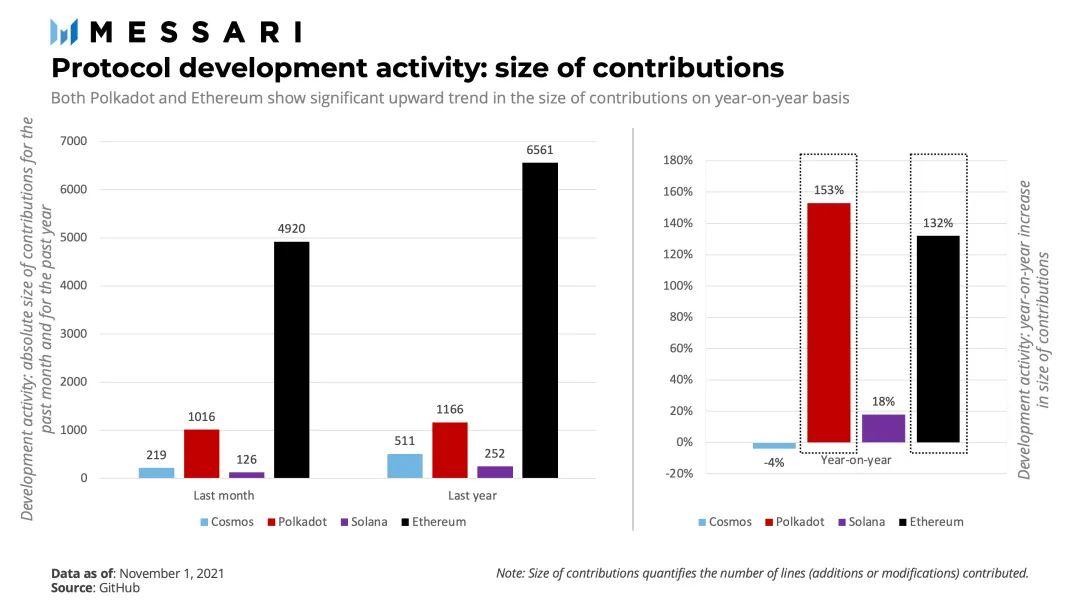
Protocol Developer Community
The active developer community for each of the four protocols continues to rise. Ethereum's monthly active developers are nearing 250, while Cosmos, Polkadot, and Solana remain relatively stable at around 50. Interestingly, Polkadot, Cosmos, and Solana have all recently managed to attract an increasing number of monthly active developers. This aligns with the current capital and talent migration from Web 2 to Web 3.
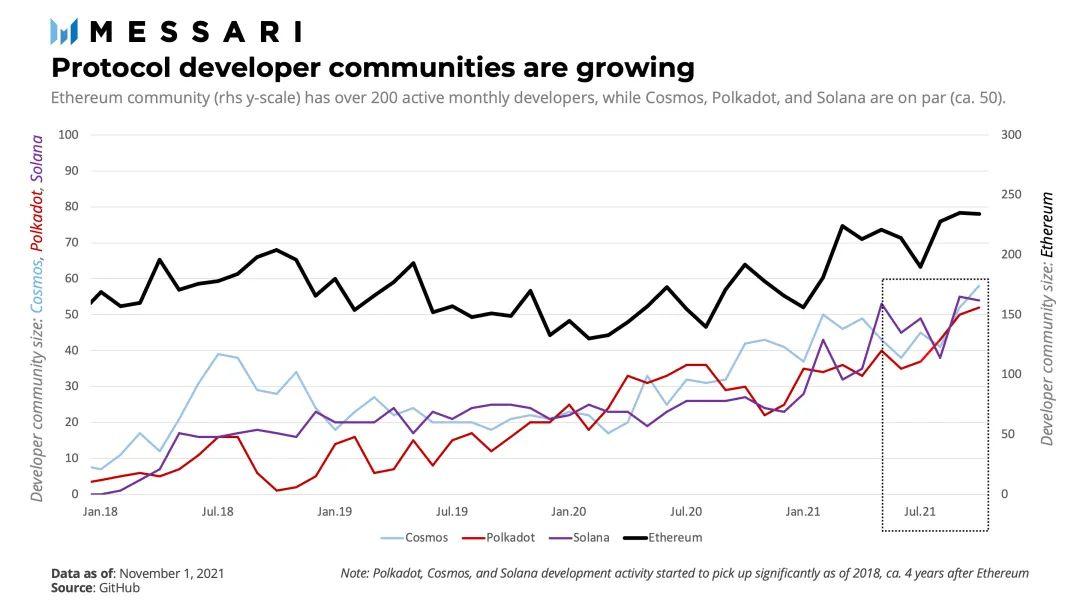
This upward trend in the size of the developer community is good news for the blockchain space: developers will continue to work hard and further drive ongoing protocol development.
Ecosystem View
That said, protocols only generate value when they have thriving, useful, and utilized application ecosystems. These application ecosystems are developed by open-source communities on top of the protocols themselves. To quantify the development activity at the application ecosystem level, we:
- Considered all projects ranked in the top 300 by market capitalization on CoinGecko, corresponding to each protocol ecosystem (Cosmos, Polkadot, and Solana);
- Excluded cross-chain projects.
The result of this approach is: In the Cosmos ecosystem, 15 projects made it into the top 300; in the Polkadot ecosystem, 9 projects made it into the top 300; and in the Solana ecosystem, 13 projects made it into the top 300 as of November 1, 2021. Note that Ethereum is excluded from this comparison. The reason is that, given the rapid growth and large scale of the Ethereum ecosystem, it is impractical to calculate all the new projects currently being developed on Ethereum.
Ecosystem Development Activity
While all three ecosystems have stable development activity, the Cosmos ecosystem stands out. The following chart shows that platforms and applications built on these three protocols attract a significant amount of development work. This trend is expected to continue for some time.

Zooming in, when comparing year-over-year contributions, the development activity in the Polkadot ecosystem has strengthened year-over-year, especially relative to the Cosmos and Solana ecosystems. Similarly, this strengthening of Polkadot ecosystem activity occurred before the first parachain slot auction in November 2021.
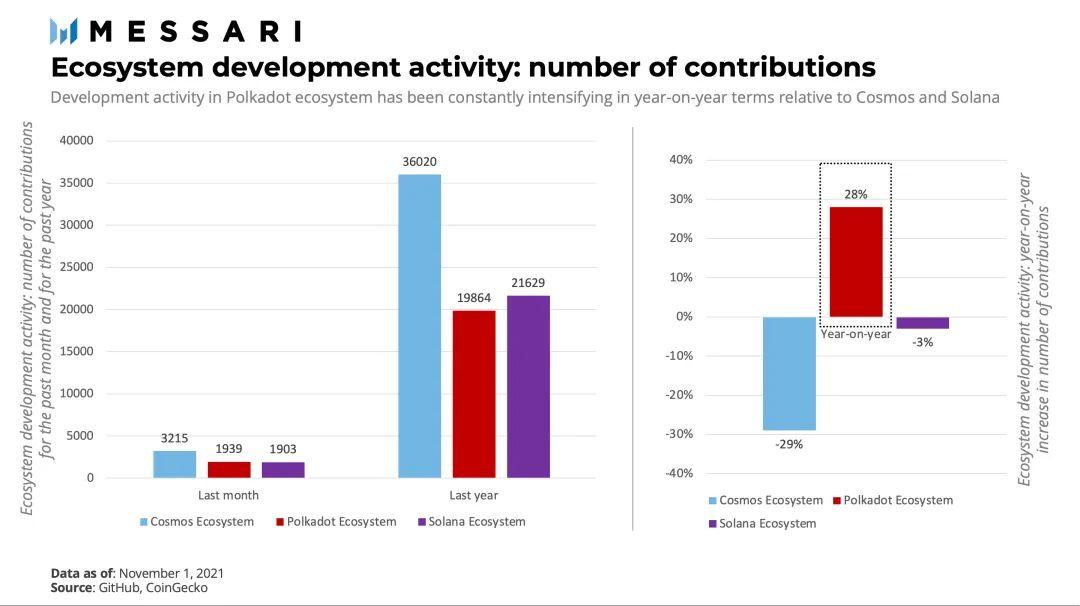
In terms of the scale of contributions (measured by increases or modifications to the code), on a year-over-year basis, the Polkadot ecosystem (+32%) has outperformed the Solana (+9%) and Cosmos (+5%) ecosystems in terms of growth. This finding is consistent with the trends in contribution numbers mentioned above.

Ecosystem Developer Community
In terms of growth in the ecosystem developer community, all three ecosystems seem to be attracting an increasing number of developers, particularly the growth in the Solana and Polkadot ecosystems. While many factors may be at play, one potential explanation for this adoption is that application development on the Solana and Polkadot blockchains is done using Rust—one of the developers' preferred coding languages. Rust is a coding language that the general developer community is very familiar with. This may make it easier for developers to build more applications, potentially facilitating year-over-year growth in the Polkadot and Solana ecosystems.

Conclusion
Ongoing code development is crucial for the long-term maintenance of value in Web3 protocols. Beyond the hype surrounding Web3 protocols, code development across all major protocols and their ecosystems is healthy.
From the protocol perspective, both Polkadot and Ethereum show a clear upward trend in both the number and scale of contributions. Meanwhile, the developer community shows healthy growth across all major protocols, with Ethereum clearly having the largest and most active developer community. Currently, Ethereum maintains its first-mover advantage relative to all other major protocols.
From the application ecosystem perspective, development activity in the Polkadot ecosystem has recently been strengthening, coinciding with the parachain auctions. At the same time, the absorption of the developer community in the Solana and Polkadot ecosystems may be due to the relative ease of building applications on these two blockchains.
In short, developers will stick around and "expand the pie" through ongoing Web3 protocol development. This is good news for the application ecosystems built on top of major Web3 protocols.











